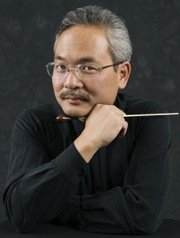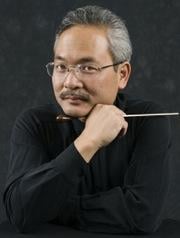The Peninsula Symphony Orchestra and Stanford Symphonic Chorus can reliably be depended on to present an engaging holiday concert. This year’s, at Stanford’s Memorial Church on Friday, was particularly interdisciplinary, offering instrumental works that had no explicit connection to the season but that proved to be cheerfully appropriate nonetheless.
The main event, though, was directly on target subject-wise: Hodie (This day), an Advent-Christmas cantata by Ralph Vaughan Williams. Both in seasonal subject matter and in scale, as an hour-long work of multiple movements in varying style, calling for two choruses and three soloists, Hodie occupies an artistic niche, you might say, similar to that of Part 1 of Handel’s Messiah. Although Hodie isn’t about to replace Messiah as the default seasonal extravaganza, it deserves an occasional airing such as this.
Vaughan Williams wrote the work in 1953-54, near the end of his life, though you’d hardly know it. In temperament — a mixture of hearty extroversion and contemplative mysticism — it resembles his earlier choral works, both secular and sacred, all the way back to A Sea Symphony some 50 years earlier. The former work’s booming first movement breathes the same salt air as the similarly broad opening of the latter work, and some of the pastoral inner movements even have a slight echo of its hushed nocturne. Hodie’s texts demonstrate the composer’s continued literary interests, including Christmas poems by his second wife, Ursula, a poet of some reputation, as well as others by the likes of John Milton and Thomas Hardy.

Stephen M. Sano conducted both the Stanford Symphony Chorus, of which he is music director, and the Peninsula Symphony Orchestra, the massed forces sending out a welcome clamor. The sheer size and noise of the orchestra, though, tended to push down the chorus in the louder passages to the level of a contributing element. Possibly the balance was better for those few audience members who ventured up to the balconies in the church transepts. Fortunately, the chorus got its own back in a couple of unaccompanied movements. While canonic entrances were a little dicey, the chorus was gratifyingly steady, rich, and full whenever all the sections sang together.
Of the three solo singers, baritone Kenneth Goodson was the best. He gave character and emotion to his two pastoral Christmas poems. Tenor Brian Thorsett was dramatically exciting in his role as the advent angel (more on that below), far outstripping a rather bland rendition of the already dull hymn that is the tenor’s only other major solo. The soprano, Elyse Nakajima, was frustrating to hear; it’s unfortunate that her lovely voice was simply too small to carry the sound of her notes even into the front of the audience, and her phrasing was a bit stiff.
Marvelous Moments
Vaughan Williams interleaves the more literary choral pieces and solo arias of Hodie with segments of Gospel narration, given to a separate treble choir accompanied by organ, all using a similar style with repeating motifs. These were sung by the women of the Stanford Chamber Chorale, directed by Victoria Chang and accompanied by Glen Frank. The sounds emerging from the organ loft in the rear of the church were the best of the concert: pure, clear, and elegantly chaste. In some of the narration sections, lines are given to the angel announcing the conception and birth of Jesus, sung by Thorsett, and to a heavenly host, portrayed by the main chorus. In each case the singers bring in orchestral accompaniment with them. The spreading and broadening of the sound, not to mention the seamless way it moved from behind the audience to in front as drama enters the narrative account, made for marvelously thrilling moments, worth the admission all by themselves.
The instrumental half of the program consisted of Vaughan Williams’ short, lyric violin concerto, The Lark Ascending, and two antiphonal brass pieces, Canzona noni toni à 12 and Sonata pian e forte, by Giovanni Gabrieli. The Peninsula Symphony’s music director, Mitchell Sardou Klein, conducted the concerto, and its assistant conductor, Jessica Bejarano, led the Gabrieli.
As a depiction of a bird in joyous flight, Lark might seem better suited for a spring concert than one on the cusp of winter. Yet that would be too limited a view. Rather than being light and bouncy, the work is rapturous and sacramental, and never more so than when the lark is played on the violin of Scott St. John of the St. Lawrence Quartet. The soloist’s firm, dark, and reedy tone perfectly offset the liquid succession of notes of the lark in full flight, and St. John knew just when to pull back into a slightly detached distance for a contemplative effect. This was a gem of a performance, cool and clear and exactly right for the season. The orchestra’s strings provided firm support, and beautiful brief solos came from all over the wind section.
Gabrieli’s bright, chipper Canzona, for three brass choirs spread across the front of the church, made for an equally toasty wintry sound. The Sonata, for a single antiphonal choir (horns and trumpets on one side, trombones and tuba on the other), was a more drab affair. Both, however, were played with energy and precision.
All around, this concert made for good warm music for listeners to warm themselves with on a soggy evening on the Peninsula.

